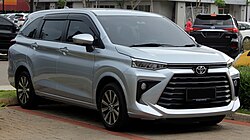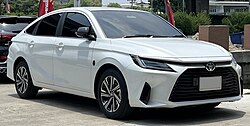Applications
The chassis, which is the main component of the platform is grouped into three types, which are the kei car segment, A-segment, and B-segment products for emerging markets. [1]
Kei cars
Vehicles using platform (calendar years):
- Daihatsu Tanto / Subaru Chiffon — LA650 (2019–present) [12] [13] [14]
- Daihatsu Taft — LA900 (2020–present) [15]
- Daihatsu Hijet Cargo / Atrai / Toyota Pixis Van / Subaru Sambar Van / Sambar Dias — S700 (2022–present, RWD-based) [16]
- Daihatsu Move Canbus — LA850 (2022–present) [17]
- Daihatsu Move / Subaru Stella — LA850 (2025–present)
- Daihatsu Tanto / Subaru Chiffon
- Daihatsu Tanto Custom / Subaru Chiffon Custom
- Daihatsu Taft
- Daihatsu Hijet Cargo / Toyota Pixis Van / Subaru Sambar Van
- Daihatsu Atrai / Subaru Sambar Dias
- Daihatsu Move Canbus
- Daihatsu Move / Subaru Stella
A-segment (DNGA-A)
Vehicles using platform (calendar years): [18] [19]
- Daihatsu Rocky / Toyota Raize / Subaru Rex / Perodua Ativa — A200/A250/A270 (2019–present) [20] [21]
- Daihatsu Ayla / Toyota Agya / Toyota Wigo / Perodua Axia — A350/A300 (2023–present) [22] [23] [24]
- Daihatsu Rocky
- Toyota Raize
- Subaru Rex
- Perodua Ativa
- Daihatsu Ayla
- Toyota Agya
- Perodua Axia
B-segment (DNGA-B)
Vehicles using platform (calendar years):
- Daihatsu Xenia / Toyota Avanza / Toyota Veloz / Perodua Alza — W100/W150 (2021–present) [25]
- Toyota Vios / Yaris Sedan / Yaris Ativ/Vios Ativ — AC100 (2022–present) [26]
- Toyota Yaris Cross / Perodua Traz — AC200 (2023–present) [27]
- Daihatsu Xenia
- Toyota Avanza/Avanza Premio
- Toyota Veloz/Veloz Cross
- Perodua Alza
- Toyota Vios / Yaris Sedan / Yaris Ativ/Vios Ativ
- Toyota Yaris Cross



















